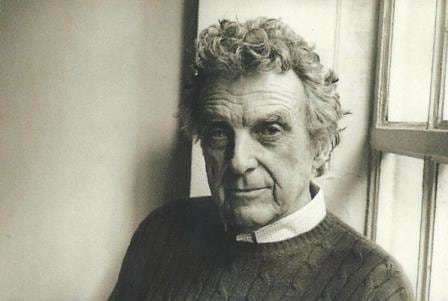
Photo by John Jonas Gruen
DON NICE
(1932-2019)
By Antonia D. Bryan
Don Nice, ranch hand and football player, outdoorsman and teacher, tough guy and lover, was always an artist at heart. His enduring love for the environment was nurtured in California's San Joaquin Valley, where his father worked for a fruit company, and his grandfather, a physician and gold miner, regaled him with tales of cowhands and '49ers, stagecoaches and train robbers. When he wasn’t in school, Nice himself grew up on the range – a sunburned teenager in chaps, herding cattle, dodging rattlesnakes and setting out barbed wire. "I became acquainted with the world,” he says, “from the saddle on a horse or the leather of my boots: slow, steady and in a focused way in which survival could depend on your familiarity with the land." The American land would remain central to his oeuvre.
Nice starred as an athlete in high school. There were no art classes, and no museums to visit. But Don loved to draw. His grandfather and his aunt, both amateur painters, encouraged his interest; his father made him a little studio in the back yard, and he signed up for correspondence courses in art.
After high school, Nice’s undeniable talent got him accepted at Art Center School (now the Art Center College of Design) in Los Angeles. But it was his prowess on the football field that won him a full four-year scholarship to the University of Southern California where he earned a teaching certificate and took art classes at night.
After graduation, Nice applied for a position as an art teacher at prestigious Hollywood High. Instead, he was placed at Andrew Jackson High School for Delinquent Boys. There, he encountered a whole new world. Almost every student was part of a gang. “It was zoot suit days, and the kids would carry chains in their [baggy] pants and go down to the middle of Los Angeles and look for the toughest marine and gang up on them.” One day, he came into class to find his biggest student standing right up front. Nice told him to take his seat. “‘You can’t sit me down, teach,’ he says. And I just gave him a cross body block, and I knocked him clear over the top of a chair, and all the rest of the class gathered around, and they were saying, ‘Hey teach, you’re pretty bad.’ The guy got up, and we shook hands. That was a test, you know.”
After the Korean War, Nice volunteered for the draft, gaining education benefits from the GI Bill. He spent two years in the United States Army at Fort Ord on the California coast as a company-level illustrator, cheering his fellow soldiers with a twenty-four foot mural of potato peelers in the mess hall. He also taught art at Monterey Peninsula College, and exhibited at the Carmel Art Center, where an important collector, Helen Potter Russell, took an interest in him and exposed him to the work of van Gogh.
In 1957, after his discharge from the army, Nice was eager to catch up on his artistic education. He set out to study painting in Rome, all his worldly possessions in a single bag. But during a short train layover, he was seduced by the beauty of Florence, and he spent the next two years there, soaking up the glorious legacy of Europe. It was a new kind of culture shock. “I thought Vivaldi was another form of spaghetti, you know.”
With one of many artists he met in Florence, Nice puttered around Europe on a Vespa, landing briefly in Salzburg in 1958 to study watercolor with the brilliant master of expressive brushwork, Oskar Kokoschka (1886-1980). The class was a revelation. Kokoschka proclaimed that it was “about painting, not paintings,” and demanded his students produce four watercolors an hour, eight hours a day, painting directly -- from the heart, not the head. When he found Nice sketching, he confiscated his pencils, exclaiming, “We are here to paint!” Nice left with a cash prize and a new vision. Kokoschka, he maintains, taught him how to see.
Nice used the money to go to Paris. There, he encountered the groundbreaking exhibition The New American Painting, curated by Dorothy Miller from New York’s Museum of Modern Art. Nice was exhilarated by the scale and artistic possibilities he saw in abstract expressionism -- in the gestural bravado of Willem de Kooning and Jackson Pollock’s startlingly original canvases, with no point of perspective and no definable ground. New York was the center of art now; he could no longer stay in Europe.
In a French class in Paris, he had made another life-changing discovery: “a beautiful set of legs” belonging to Sandra Smith, a model and designer from Minnesota. Her lively sense of humor and down-to-earth approach matched his own. “On our first date, I said, ‘You have an absolutely beautiful neck.’ You know what she said? ‘Yeah, it holds my head up.’” They decided to get married. “I’ve been lucky all my life,” says Nice, “everything just has been falling right into place.”
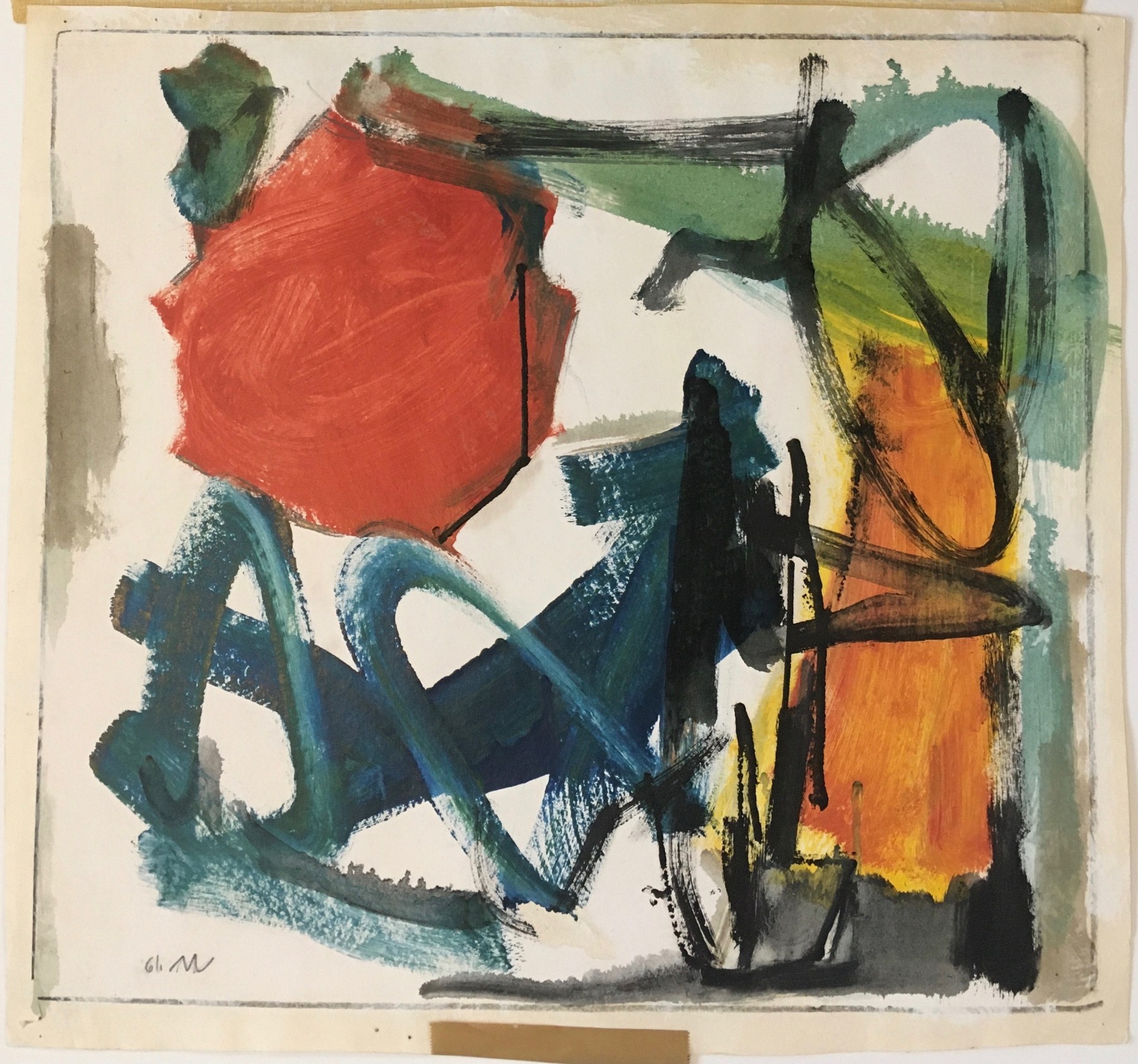
Untitled, 1962 Watercolor 15" x 16"
Back home in the United States in 1959, Nice taught Painting and Design at the Minneapolis School of Art. In 1962, at the age of 30, he was accepted at Yale’s celebrated Graduate School of Painting.
At Yale, it was Alex Katz who really spoke to him, encouraging his students to be inventive, artistically informed and deeply self-aware. And to “get subject matter back into painting.” Fellow students included Chuck Close, Nancy Graves, and Richard Serra, all grappling with finding new directions.
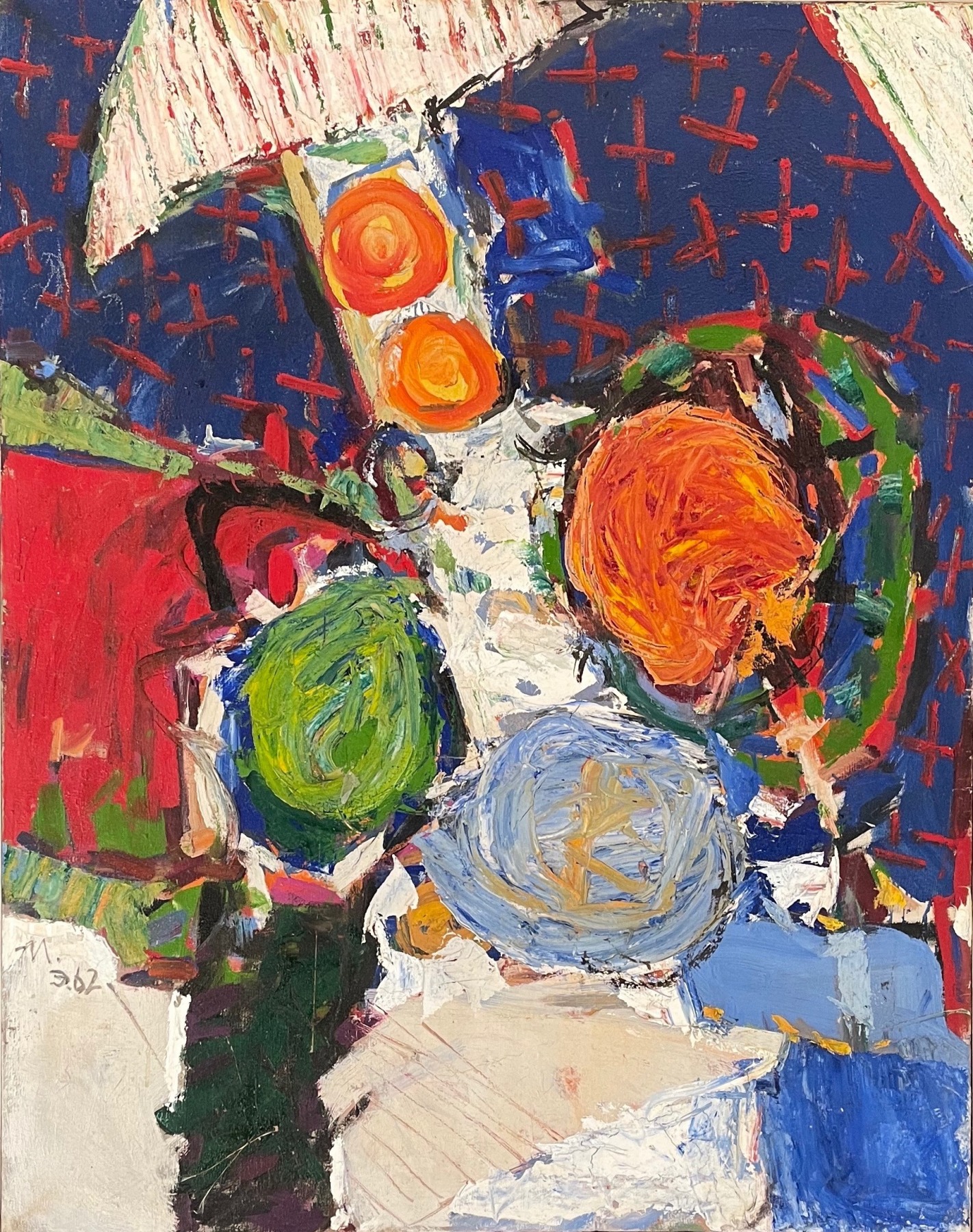
American Super, 1962 Oil 38" x 30"
1962 and 63 were crucial years. After Yale, Nice finally settled in New York, where he found himself struggling to emerge from the abstract expressionism that had drawn him back across the Atlantic. “It took me five years to get de Kooning out of my hand,” he remembers. Recognizable objects were anathema. “I’d be doing a painting, and suddenly there’s a big red blob, and people would say, ‘That looks like an apple,’ so I’d paint it out.” American Series #5 was a successful endeavor, but Nice has since destroyed most of those works. “I was getting messages. The little angel on my shoulder was telling me: ‘Don, wake up, something’s happening here.’”
The truth was, Nice instinctively needed to paint things. “And so then, there was a huge problem. How do you paint them?” The New York artists debated such questions endlessly. “We wanted to do something that was entirely revolutionary.”
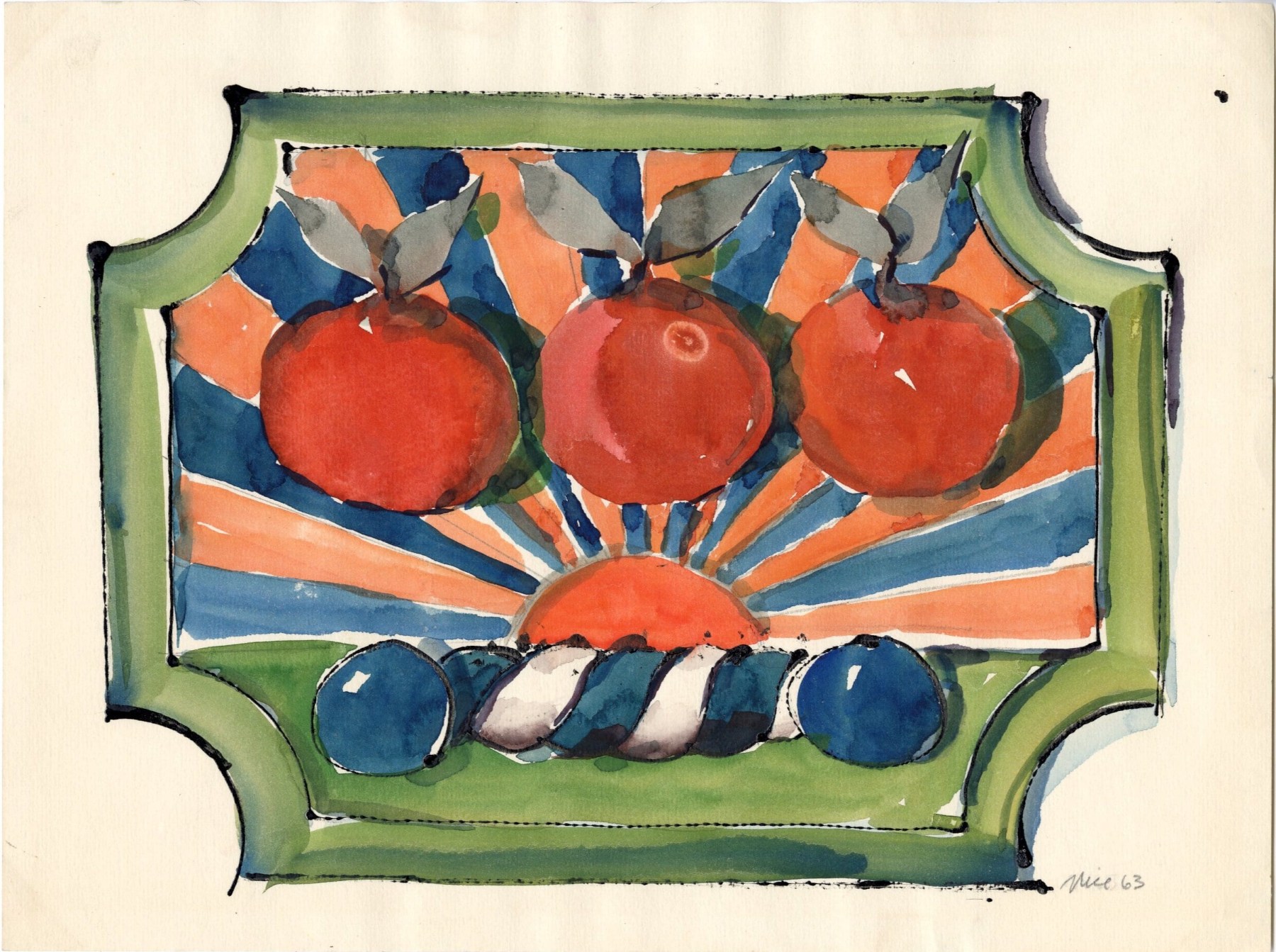
Market Emblem Study #11, 1963 Watercolor 9" x 12"
In 1963, Nice started painting larger-than-life American motifs based on labels and ads, such as Sunkist, or Starkist (his father had worked for a fruit company). These images filled the canvas, without perspective or perceptible light or shadow, and emphasizing the flatness of the picture plane.
In 1966, teaching summer school in Minneapolis, he began to paint isolated objects, striving for clarity above all. He painted huge beets and gargantuan onions. He wanted his work to be true to experience and materials, to be instantly accessible, without ambiguity. He eliminated background, working directly on unprimed canvas – allowing viewers themselves to provide context. “Getting rid of the background freed the object,” he said. “I wanted a still life that really had energy.” He wanted to create “a new sensibility,” to engage people, to show them how extraordinary the ordinary truly was.
One triumphant realization of this goal began with the simple purchase of a supermarket bunch of grapes. He painted one bunch, then another and another. The canvases grew and grew. The largest, created in 1967, was nine feet tall. “At nine feet,” he says, “they had a presence.”
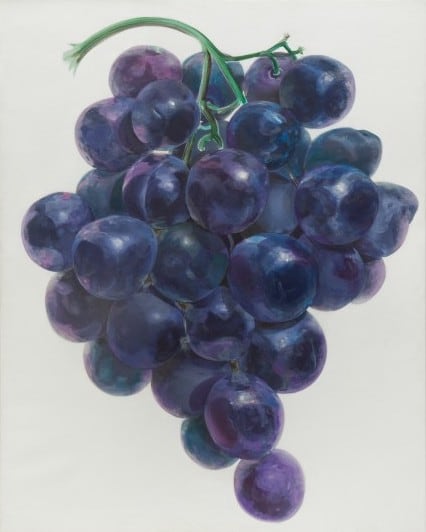
Purple Grapes, 1987 Acrylic 60" x 40"
The grapes offered myriad possibilities. From a distance, the bunch formed a single image; close up, it broke into multiple parts -- each grape had an individual character. Eliminating reference to time or place allowed viewers to associate freely, shifting between the universal and the personal -- from ancient painted vessels to 17th-century still lifes, from winemaking to family picnics, from Aesop’s fables to The Grapes of Wrath to Mae West’s famous, “Beulah, peel me a grape.”
He continued to paint single American images – a lobster, an eagle, sticks of gum, apple pie, reaching through the specific to the universal. And in 1968, his work was included in Realism Now, a seminal exhibition at Vassar College on the burgeoning realist movement. He was evolving, finding his own unique voice. The same year, when he bought a toy fire truck for his son, the boy asked him, “Where is the dirt, Daddy?” It was time to get his family out of the city.
Nineteen sixty-nine brought sea changes. The Nices moved to Garrison, New York, to an elegant rambling old house with a long front porch facing the Hudson River. Nature was at Don’s doorstep, and the connection was immediate and profound.
Tragedy struck the same year: his older brother Hubert, a botanist, died from inhaling insecticide. Don found himself increasingly aware of the fragility of life. He found it impossible to look at nature without considering the effects of toxins on what he saw. The Hudson flowing at his feet was filthy; the wildlife that was its beating heart was threatened. Nice’s neighbors included environmental writer and activist Bob Boyle, Pete Seeger, and John Adam, who would later head the National Resources Defense Council. The environmental movement was being launched in his own back yard. But for Nice, the environment was not a question of politics or proselytizing; it was “a matter of life and art.” The animals of the Hudson Valley became iconic motifs in his work – bears and blue jays, squirrels and trout, robins and butterflies and coyotes. He could no longer paint them without thinking of their value and their fragility, and the preciousness of the earth.
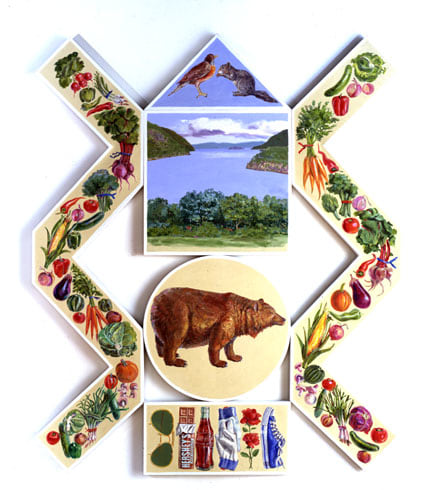
Zig Zag Cornucopia, 1981 Oil 108" x 92"
The accumulation of images turned out to be an especially rich avenue of exploration, further enhanced by swags on either side. Zig Zag Cornucopia of 1981 epitomized the riches of the Hudson River Valley, formally arranged around a square painting of what had become the quintessential view of the Hudson Highlands near Nice’s Garrison home. Along the bottom, a rectangular predella of six images includes a sneaker, gardening gloves, a Hershey bar and roses; above is a tondo, or round painting, of a brown bear, and, at the very top, a triangular pediment incorporating a squirrel and a robin. Vegetables grown in the Hudson valley tumble down zig zagging ribbons on either side. The amalgam of shapes in itself is mesmerizing, the spaces between them adding further interest. Nice would pursue this line of thought throughout the eighties, sometimes with the spaces literally empty, sometimes, filling them with neutral areas of paint.
Nice had also explored other ways to incorporate multiple images in a formally satisfying whole. He looked to unexpected sources, such as heraldic emblems, and Native American totems. The resulting forms ranged from American Ziggurat #2, with nine square images arranged in decreasing rows, to Peaceable Kingdom of 1978, over 9 feet tall and 36 feet wide, comprised of 50 individual watercolors on either side of a large central acrylic painting with images of domestic animals -- a sheep, a pig, a chicken, cattle, a dog. Peace is the watchword of many Nice paintings, for his individual images are often still, as if waiting for us to contemplate, engage, and observe.
In the early nineties, now deeply involved in environmental concerns, Nice would expand this idea conceptually. In Earth Grid, 1991, the images are anodized aluminum cutouts painted with organic dyes. Seventy four of them are arrayed around three iconic motifs – a bull, a bear, and a central image of the earth seen from the moon, or, in a second version, the Hudson Highlands. The elements have been arrayed on a black wall divided into a grid by chalk lines, like those used centuries ago to enlarge wall paintings, or by Nice himself to make his nine foot Grapes back in 1967. In this configuration, the viewer is overwhelmed by the abundance of images, and as one approaches, they seem to wrap around, filling the field of vision. At the same time, the cutouts turn out to be endlessly flexible, for as individual pieces with no physical connection, they can be displayed in any formation -- even scattered on the floor, stacked, hung from the ceiling or split up into groups. “Earth Grid,” he has said, “is really my universe… It is the Hudson River Valley, it is the entire world. It is who I was and who I have become as a person and as an artist.”
Nice was by now deeply committed to a vision of environmental harmony and integration, recalling the 1960s philosophy of James Murdoch, who saw the earth as Gaia, a super-organism. The dramatic Hudson Highlands, with their transcendent natural beauty, profound historic resonances and views painted for centuries, often came to represent the earth.
In 1985, Nice had set aside time to concentrate on his profound and enduring bond with the Hudson, whose deepest channel was just a mile upstream from his Garrison home. “I felt this need to embrace it and to come to some understanding of my own relationship to it.” He wanted to reconnect with spontaneous watercolor too. He spent two weeks following the great river, from its source in Lake Tear in the Clouds high in the Adirondack Mountains, over 300 miles, all the way down to New York Harbor. The result was over 90 small works, painted rapidly and directly from nature as Kokoschka had taught him so many years earlier, often executed sitting in a boat or even on a raft in a wet suit. In the late nineties, he would do another less extensive series, and again in 2013, showing the river from above.
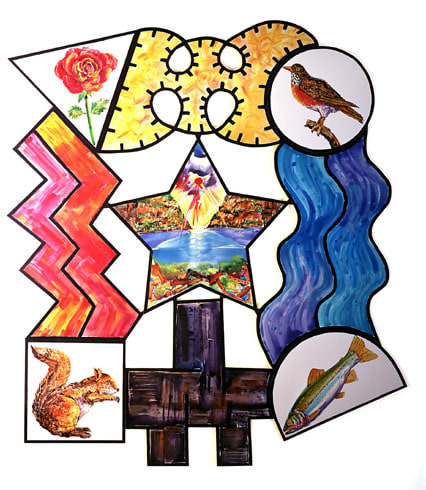
Earthscape, 2001 Anodized Aluminum 58" x 52" x 3"
In the new millennium, as Nice considered folk art such as quilts and whirligigs, shapes evolved even further. He had used star motifs since the 60s; now 5-pointed stars became the actual shape of paintings, objects in themselves which broke down into a central pentagon, with a triangle on each side. Each form contained its own object. The favored ground was aluminum, which reflects light through organic dyes, enlivening their color and creating, says Nice, “a visual experience that is new and different from that of any other.”
“Spinners” were another invention -- paintings on aluminum that moved, rotating on the wall to discourage viewers from any particular orientation, or even hanging from the ceiling, literally spun by the breeze. These pieces incorporated a symbolic vocabulary of elements – both abstract and realistic, which had come to appear often in his work. At first, there were four: earth, wind, fire and water; then, a fifth: gravity, sometimes represented by an apple, a nod to Sir Isaac Newton.
Believing deeply in the interdependence of man and nature, Nice’s landscapes have become earthscapes, blending the natural and the manmade, abstraction and realism, painting and sculpture and movement. In painting what is in his heart, he gives us himself and what he sees, inviting us to give of ourselves in return. Joseph Conrad said that writing could provide “that glimpse of truth for which you have forgotten to ask.” Don Nice’s vision, born in the American West, nurtured in Europe, and manifested in emblems of America and the water and skies and earth of the majestic Hudson River Valley, draws us into the universal by means of the particular, demanding our attention, and reinforcing our inextricable connections to the forces of nature and the nature of the universe.